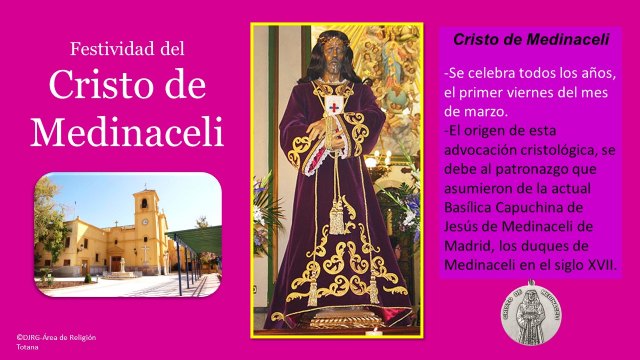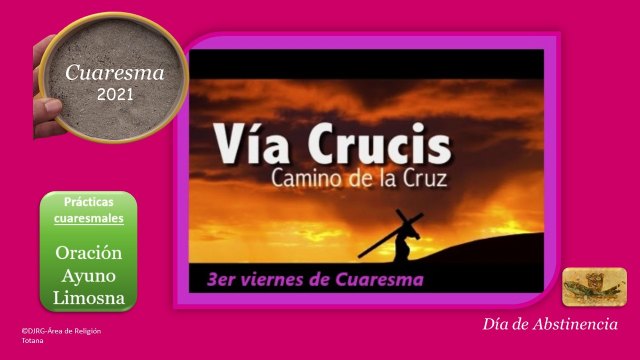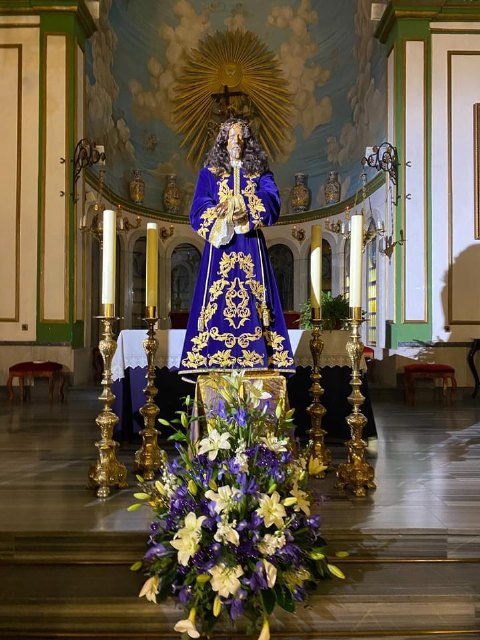Coinciding this year with the third Friday of Lent, the residents of Totana celebrate once again, the feast of Christ of Medinaceli . This is a festival that is deeply rooted in our town, -also in many other towns in our Region-, and according to ancient chronicles it has been celebrated since the 19th century, as its devotion in Totana is associated with the arrival of the Capuchin Friars.
to our Municipality, since they were the ones who brought it with them. It is a festival that has overcome the vicissitudes of time, and has endured in the memory and in the devotion of the totaneros, throughout more than twelve decades.
It has even adapted for the second year in a row, to the security requirements that the current pandemic that we are experiencing and suffering from, has imposed on us. What does this image of Christ represent? The Christ of Medinaceli, also known as Nuestro Padre Jesús de Medinaceli, is an image of Jesus of Nazareth that evokes the moment of his Passion, when Pontius Pilate presents him to the people, on the first Good Friday in history. After having been tried four times, the Roman attorney has one last idea, to try to free Jesus.
He orders the flagellation, and after this, he gives the people a choice between the freedom of Jesus or that of the murderer Barabbas.
The image represents Jesus, as the Jewish people would see him twenty centuries ago in the courtyard of the Praetorium: bound as if it were a dangerous and aggressive bandit, scourged, crowned with thorns, and with a face full of pain, after having suffered all kinds of outrages, and having been cruelly beaten. The current image of the Christ of Medinaceli that is venerated in Totana in the Parish of the Three Ave Marías, was blessed on March 5, 2009, 12 years ago today. When is the feast of Christ of Medinaceli celebrated? It is always celebrated on the first Friday of the month of March .
This day, the Chapel in which the image is located receives the visit of hundreds and hundreds of Totana residents who come to pray, to entrust themselves to the image of the Nazarene, and to comply with the traditional rite of kissing. What is the rite of kissing? Tradition tells us that on this day a visit has to be made to the image of the Christ of Medinaceli, to pray before it and kiss the foot of the image. Logically, -and like the previous year-, the kissing rite will not be performed , being this replaced by the bow of the head, as a preventive and security measure in the current pandemic situation.
The proper separation distances between the attendees will also be kept at all times , and it will be rigorously ensured, so that the capacity is not exceeded at any time. The kiss at the foot of the image (and on this occasion, the inclination of the head before the image), is not only a sign of devotion, but it is a sign of the external manifestation, of the internal love that all Christians profess and feel towards Jesus the Nazarene. According to the centennial tradition of Totanera, before the image of Jesus de Medinaceli, the devotees pray three Creeds and express the three wishes that we most need Jesus to grant us.
The wishes that the devotees ask the most are that he free us from all kinds of “captivity”, that is, from diseases, from seeing ourselves out of work, from falling into quarrels, etc. The history of the devotion to the Christ of Medinaceli. The original image of the Christ of Medinaceli is preserved in the Basilica of “Jesús de Medinaceli” in Madrid.
This image dates from the first half of the seventeenth century and was commissioned by the Capuchin Fathers of Seville, who brought it to the Spanish colonies in North Africa. In the summer of 1682 , the image arrived in Madrid, after being rescued by the Trinitarian Fathers, who managed to negotiate its “rescue”, since it had fallen into the hands of the Muslims (hence it is also associated with the denomination of Cristo del Rescate or Rescued). That same summer of 1682, the first procession with the image of Cristo del Rescate was organized in Madrid.
According to the chronicles of the time, this procession was attended by "all of Madrid", including the Royal House. Liturgical activities planned in the Parish of the Three Hail Marys: The doors of the Parish will remain open from 07:00 in the morning until 21:30 at night, uninterrupted hours. Two Masses will be celebrated: one in the morning at 09:00, and another in the afternoon at 19:30. At the end of the afternoon Mass, the corresponding Stations of the Cross will take place on the 3rd Friday of Lent.




